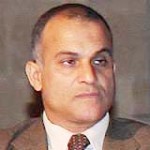Before President Morsy had announced former Minister of Irrigation Hesham Qandil as Egypt’s new premier, columnists across the Egyptian press tried to analyse Morsy’s proper powers in the constitution. Elsewhere, several columnists have continued to explore the 60th anniversary of the July 1952 revolution, while comparing the of the July coup d’état with the January 25 revolution.
 Amro Rabie Hashem
Amro Rabie Hashem
Al-Masry Al-Youm newspaper
What the President’s powers actually amount to should be regarded as a weighty component in Egypt’s new constitution.
How these powers manifest in reality will be the blueprint for the relationships between Egypt’s power brokers and the real importance lies in making sure that the past is not repeated.
In his column, Amro Rabie Hashem suggests that a mixed system of government should be the only solution for Egypt’s political crisis.
Unlike presidential or parliamentary systems, the mixed system brings together elected institutions; the presidency and parliament, and sets bold lines between the country’s three authorities.
Hashem lists the president’s powers that should materialize in the coming phase.
In the writer’s estimation, Morsy should have the power of appointing high-profile employees, heading the cabinet’s regular meetings, presenting draft laws for the parliament and have the right to criticise any of those passed by the former.
The President should also issue Presidential decrees and announce states of emergency under certain conditions.
In addition to this, the President should have a fundamental role in the formation of government and the dissolution of parliament.
As for the government’s role, Hashem affirms that its main role lies in regulating public policy and the implementation of laws.
The military forces should fall inferior to the government, as it will be hold accountable in front of the People’s Assembly.
In this system, the writer believes that a national association will supervise both the President and the government.
 Emad Al-Din Hussein
Emad Al-Din Hussein
Al-Shorouk newspaper
One of the debates currently occupying public opinion is the conflict between Cleopatra Ceramics owner, Mohamed Abu Al-Enien, and his workers, as well as the dispute between Egypt’s Mahalla Textile workers and Chairman of the Spinning and Weaving Holding Company, Fouad Abdel-Alim. Emad Al-Din Hussein states that while some discuss the details of the conflicts, many place emphasis on which party is to blame.
The principal element, in the writer’s eyes, should raise the question of whether or not there are fair regulations that govern the relations between employers and workers in Egypt.
This conflict’s roots stem back to Mubarak’s old regime as he helped in founding a mood of prejudice towards workers.
In Hussein’s estimation, most businessmen during Mubarak’s dark 30 years were corrupt and were accustomed to dealing with workers in an oppressive manner.
After the January 25 Revolution, the writers affirms that there is neither excuse nor logic allows millionaire businessmen to simply acquire wealth and affluence while walking all over their workers.
Hussein expresses his concern from the flagging volume of production due to the negative working conditions that operate in Egypt’s large companies and factories.
It is essential that all parties revisit the goals of the January uprising and work on implementing social justice as one of its first objectives.
Wrapping up his piece, Hussein calls on President Morsy to intervene for the benefits of the many downtrodden workers.
 Mohamed Essmat
Mohamed Essmat
Al-Shorouk newspaper
On its 60th anniversary, nothing remains of the July 1952 Revolution but a blend of tarnished revolutionary thought, a set of social achievements for the poor, and bitter memories of the June 1976 war.
Recalling 1952 revolution, Mohamed Essmat assess the concept of Nasserism and describes former leader Gamal Abdel Nasser as ‘the man of big contradictions and fatal mistakes’.
He asserts that Nasser’s main blunder came when he lost confidence in his own people; the Egyptian people having previously provided him with legitimacy and the impetus behind the 1952 Revolution.
In an attempt to assess Nasser and his rule, the writer states that he later managed to properly play the role of a dictator, especially when he used severe oppressive methods against his opponents.
The Nasserism debate remains torn along party political lines of the left and the right.
The former leader had enjoyed plenty of legitimacy, especially after his decision to nationalize the Suez Canal, there was no great need for him to fix presidential elections to win with 99.9 %.
Essmat believes that the Nasserite concept established a police state with a socialist front.
In the end, the columnist argues that Nasserites carry on striving to achieve a true ‘people’s socialist association’ while clashing with the multi-partisan concept.
Until the group resolves this dispute, the writer estimates no future for Nasserism as a political trend.
 Ahmed Mansour
Ahmed Mansour
Al-Watan newspaper
Revisiting the Tunisian revolution, Ahmed Mansour compares the Tunisian police to those in Egypt, stating that former security apparatus was also devoted to the former corrupt regime.
After the success of both uprisings, the problem remained in how to restore these institutions and build mutual confidence with the people.
Hatred has always surrounded the building of Cairo’s Lazoghly Security Apparatus, a situation similar to the Tunisian National Security building.
Mansour states that unlike Tunisia, which managed to restore confidence in the police as an institution, after the January 25 Revolution, Egyptians have lost any feeling of respect towards police and security officers.
Calling upon Morsy to take steps in reinstating the once respected police institutions, the writer affirms that police officers will not be able to dissolve this issue on their own.
Security in Egypt will never be imposed without the interference of presidency, in Mansour’s estimation.
He further suggests that Morsy would help police officers by presenting to the parliament a set of regulations that govern their rights.
Another of his recommendations is that Morsy should order constant shifts of police officers to patrol the country in an effort to eliminate all sorts of chaos and danger.
Considering Morsy’s plans for his first 100 days, the writer finally places emphasis on the importance of a strong police presence, so as to deliver the his security commitments.
 Mohamed Al-Kholy
Mohamed Al-Kholy
Al-Tahrir newspaper
July and January are only a small number of months apart, but drastic changes have occurred in Egypt between 1952 and 2011.
Mohamed Al-Kholy states that the difference between the July and January revolutions is that the former was a military coup d’état transformed into a popular uprising, where as the later is a popular revolution that reverted to a military coup d’état.
Al-Kholy, returning to the evening of 11 February 2011, when Egyptians rejoiced the ouster of Mubarak and his regime, expresses his astonishment at those who mourned Omar Suleiman who was regarded as Mubarak’s right arm.
He condemns those who grieved the former Vice-President while recalling how many martyrs fell at the hands of military rule in clashes on Mohamed Mahmoud Street and at the Ministry of Interior.
Al-Kholy ends his piece denouncing the military junta while placing stress on all destructive consequences of their rule.
He recalls a scene of a female protestor holding the portrait of Gamal Abdel Nasser and chanting ‘down down with the military rule’.
The writer considers the irony of this image given Nasser’s preeminent military connections and asserts there is a vast difference between the army of 1952 and that of 2011.



